Taking care of the air you breathe or all about ventilation
| 05 April 2008 - Comments (0) | Construction |
 Ventilation is all about the quality of the air we breath when we are indoor. Constructions being increasingly airtight, the only way to get the fresh air we need is from a ventilation system. Of course, it is always possible to open windows but they cannot ensure a constant supply of fresh air. This article explain why we need ventilation, and look into the current solutions on the market.
Ventilation is all about the quality of the air we breath when we are indoor. Constructions being increasingly airtight, the only way to get the fresh air we need is from a ventilation system. Of course, it is always possible to open windows but they cannot ensure a constant supply of fresh air. This article explain why we need ventilation, and look into the current solutions on the market.
Need for ventilation
Apartments or houses are closed spaces in which we spend a great deal of time, particularly in the cold season. Bringing in fresh air and evacuating stale one is a necessity for indoor air quality. That is for several reasons:
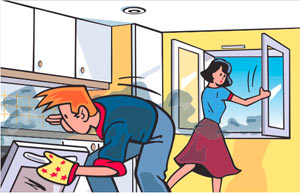
- supply oxygen we need
- eliminate odors, pollutants and allergens
- eliminate the excess of humidity in the air
- provide a sense of well-being.
Despite of its importance, ventilation is very often overlooked and discarded with the common answer that you can always open windows. While opening windows is a great way to quickly and occasionally renew the air, it completely fails to provide a constant, moderate, supply of fresh air. In practice, in the cold season, windows may remain closed for extended period of time, and they cannot be left open all day long anyway as the point is also to have a warm and cosy interior. Opening windows depends on the good will of the occupants who may not realize when it is necessary to open them or cannot practically do it such as during the night. Windows cannot be a replacement for a proper ventilation system.
Consequences of poor air quality
In many countries, experience shows that failure to have proper air supply is a major issue in dwellings. Poor air quality leads to:
- increase in airborne contamination
- health hazards such as allergies, headaches, rhinitis and asthma
- reduction in air circulation
- condensation and mould growth
- accumulation of radon
- accumulation of carbon monoxide.
Condensation and mould growth will be further triggered by the combination of poor air quality and the existence of thermal bridges. Generally, the absence of ventilation in dwellings will lead to poor quality living and emphasis other problems.
From uncontrolled air leaks to controlled ventilation
Ventilation used not to be a concern in residential buildings. They were poorly insulated and air leaks on the windows and walls were plentiful. Keeping the place warm was difficult and cost a lot of energy, but air rewenal was naturally done, altought in a completely uncontrolled way. Air leaks are unequally distributed and are not controllable. Their flow vary in time and season and is either insufficient to provide enough fresh air or provide too much.
In a search for better comfort and rationalization of energy spending (after the energy crisis of the 70s), buildings started to be better insulated. Air leaks were greatly reduced and the quest for air tightness was launched. Achieving a low-energy building, requests outstanding thermal insulation, no thermal bridges and excellent air tightness. The natural ventilation of the past, based on construction defects, is not an option anymore.
The only way to maintain a healthy interior and control the spending of energy is to control the ventilation. In modern dwellings, were construction defects are minimal, a controlled ventilation system can provide air renewal that is able to adapt its flow to the inside air humidity and to the occupancy level. In fact, ventilation is such an important system that most European countries have already passed legislation to make ventilation compulsory. Serbia is not at that stage yet.
Principles of ventilation
The basic principle of ventilation in dwellings is to create air circulation from the living space to the service or wet rooms (sweeping principle). Fresh air entrances are placed in bedrooms and living room while air extraction is placed in toilet, bathroom and kitchen. To allow air circulates in the dwelling, transfer grilles can be placed on doors. Air can also circulate below doors when there is enough space between doors and the floor.
A common shortcoming found in Serbian dwellings is the installation of an intermittent small extraction fan in the bathroom without any air supply in the living part. Useless to say that this does not qualify as a ventilation system.
Ventilation solutions
Any ventilation solution has two parts: on one hand the fresh air supply and on the other, the evacuation of inside stale air. A ventilation solution must provide enough fresh air but not too much. That would result in waste of heating energy. Based on that common understanding, several systems exist, each of them having pluses and minuses.
Natural supply and extract (Passive Stack Ventilation)
This ventilation system is based on the natural air movement through the dwelling as a result of internal and external temperature differences and wind induced pressure differences. Temperature and pressure differences cause moist air to be drawn up the ducts to be replaced by fresh air through inlet vents situated in the walls or window frames of habitable rooms. A free flow of fresh air from 'dry' to 'wet' areas creates whole house ventilation.
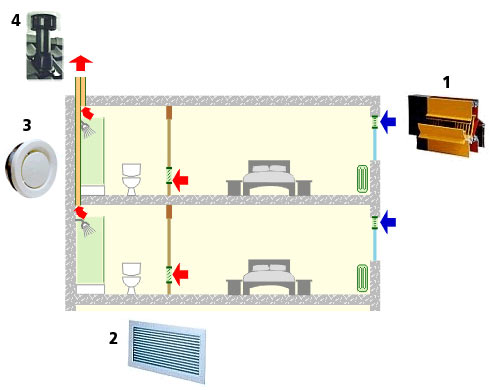
Natural supply and extraction (Passive Stack Ventilation). 1. Natural fresh air intake system, 2. Grilles for air transfer (air can also pass below doors), 3. Warm stale air extraction, 4. Natural warm stale air exhaust. (source Architecture et Climat, Université catholique de Louvain)
The fact that passive stack ventilation depends on natural motors, is a big plus: energy saving (no fan), no noise (low air speeds and no fan) and simplicity of maintenance. It is the simplest of all ventilation systems and when it is possible to implement it, it is a very good ventilation solution. Its main drawback also lies in the fact that it relies on natural motors. Passive stack ventilation might be hard to control as temperature, air pressure and humidity level vary greatly outside. It is possible to improve it further by using humidity sensitive air inlets and extract grilles.

Air exaust in the passive stack ventilation in Amadeo (photo Beodom)
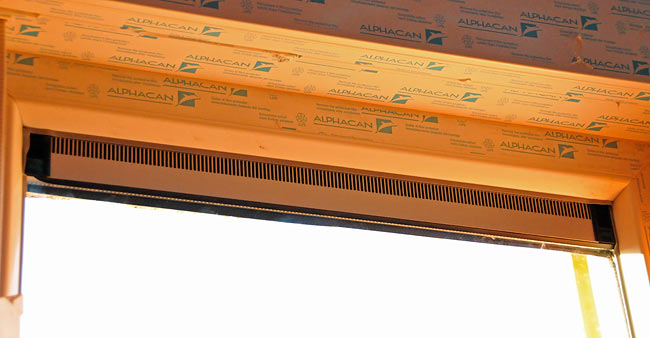
Air inlet on the windows in the passive stack ventilation in Amadeo (photo Beodom)
Natural supply / Mechanical extract
This solution is similar to the passive stack ventilation where the exaust of stale air is complemented with a mechanical extract to better regulate its flow. Fresh air is coming from air inlets located in the windows or in the walls of bedrooms and living rooms, while stale air is extracted from wet rooms such as the kitchen and bathrooms.
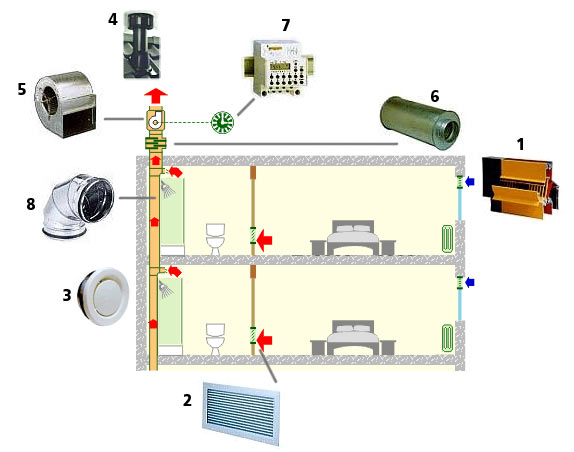
Natural supply, continuous mechanical extract. 1. Natural fresh air intake system, 2. Grilles for air transfer (air can also pass below doors), 3. Warm stale air extraction, 4. Warm stale air exhaust, 5. Ventilator, 6. Sound insulation system, 7. Electronic management system, 8. Ventilation ducts for air supply and extraction. (source Architecture et Climat, Université catholique de Louvain)
The main advantage of this type of ventilation is the fine control it gives on the flow of air extracted from the dwellings. This can be coupled with advanced humidity sensitive regulation systems that can adapt the airflow generated by the fan according to the needs of each wet room. Some systems even include presence detection to regulate the airflow.

Individual or collective treatment of the ventilation in residential building. (source Aereco)
In apartment buildings, this can be implemented through an individual extraction system in each apartment or with a single extraction system for the building.
Mechanical supply / Natural extract
In this solution, the fresh air supply is provided using a ventilator while the air exhaust is natural. This makes possible to filter or pre-heat the air before it is injected in the dwelling. The air intake can also be located anywhere (such as on the roof) which can solve the problem existing with pollution or noise getting through air inlets on the windows, if the building is located in a busy street for instance.

Continuous mechanical supply, natural extract. 1. Fresh air distribution system, 2. Grilles for air transfer (air can also pass below doors), 3. Warm stale air extraction, 4. Natural warm stale air exhaust, 5. Fresh air intake, 6. Filters, 7. Pre-heating of fresh air (optional), 8. Ventilator, 9. Sound insulation system, 10. Electronic management system, 11. Ventilation ducts for air supply and extraction. (source Architecture et Climat, Université catholique de Louvain)
Because the fresh air supply has to be conducted in all rooms, this solution requires more ventilation ducts and more work. It can be a good compromise mainly if filtering of the air is necessary.
Mechanical supply and extract
This is the most complex and expensive system in which both flows of air are controlled and regulated using a ventilator. The main advantage of such a system is that it can be implemented with a heat recovery unit.
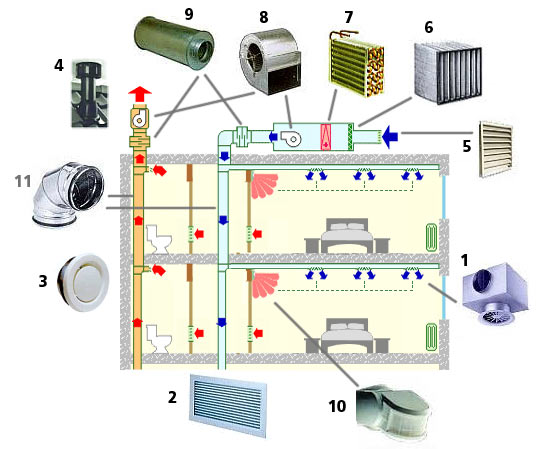
Continuous mechanical supply and extract. 1. Fresh air distribution system, 2. Grilles for air transfer (air can also pass below doors), 3. Warm stale air extraction, 4. Warm stale air exhaust, 5. Fresh air intake, 6. Filters, 7. Pre-heating of fresh air (optional), 8. Ventilator, 9. Sound insulation system, 10. Flow management system (humidity sensitive), 11. Ventilation ducts for air supply and extraction. (source Architecture et Climat, Université catholique de Louvain)
The heat recovery unit exchange the heat contained in the hot stale air taken out of the dwelling to warm up the cold fresh air getting in. Depending of the system, as much as 95% of the heat contained in the hot air can be recovered, limiting the loss of energy due to the ventilation system to a minimum.
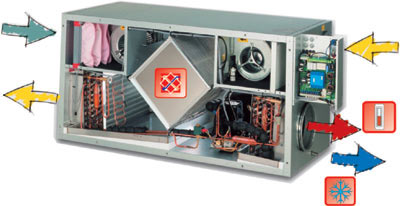
Heat recovery ventilation solution (Source Genvex)
Such a solution is better adapted for individual houses than for apartment buildings.
Conclusion
Ventilation in modern quality dwellings is a necessity for having a comfortable and healthy interior. Yet, in Serbia, it is very often overlooked or implemented badly with a single extract fan in the bathroom and no air intake. Different solutions exist to properly implement a ventilation system and the best one is function of the specifics of any given project. Nevertheless, a good choice has to balance cost, complexity, maintenance and energy spending. When it is possible, the Passive Stack Ventilation offers a simple and economical alternative and that is the one we decided to implement in Amadeo.
Other improvements such as earth cooling tubes or solar chimneys are possible and can be used to improve one of the solutions we presented in this article.






































